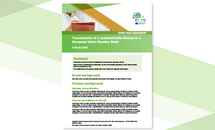Rapid Risk Assessment: Coronavirus disease 2019 (COVID-19) in the EU/EEA and the UK – tenth update
Since 31 December 2019 and as of 9 June 2020, 7 069 278 cases of COVID-19 have been reported worldwide, including 405 587 deaths. EU/EEA countries and the UK reported 1 444 710 cases (20% of all cases), including 169 207 deaths (42% of all deaths).
Executive summary
The COVID-19 pandemic is posing an unprecedented threat to EU/EEA countries and the UK and to countries worldwide, many of which have been experiencing widespread transmission of the virus in the community for several months. While decreasing trends in disease incidence are being observed in the EU/EEA and the UK overall, some Member States are still reporting community transmission. In addition, the information available from sero-epidemiological studies suggests that the adaptive immunity of populations remains low.
The absence of an effective treatment or vaccine, combined with an exponential growth in infections from late February, led many countries to implement non-pharmaceutical interventions, such as ‘stay-at-home’ policies, alongside other community and physical distancing measures, such as the cancellation of mass gatherings, and the closure of educational institutions, work places and public spaces. This approach has collectively reduced transmission and, as of 9 June 2020, the 14-day incidence in the EU/EEA and the UK overall has declined by 80% since the peak on 9 April. The initial wave of transmission has passed its peak in all countries apart from Poland and Sweden.
Although these stringent physical distancing measures have reduced transmission, they are highly disruptive to society, both economically and socially. All countries that had implemented enforced ‘stay-at-home’ orders for the general population have initiated full or partial relaxation of these measures, and several have begun a full or partial re-opening of small retail shops and other public spaces. At the present time, just before the summer holiday period, as Member States relax limitations, there is a risk that people will not adhere firmly to the recommended measures still in place due to ‘isolation fatigue’. Therefore, continuous efforts are needed to ensure that the remaining physical distancing and infection prevention control measures continue be observed to limit the spread of the disease. The pandemic is not over, and hypothetical forecasting indicates a rise in cases is likely in the coming weeks.
At this stage, the following measures are essential to maintain a reduced level of transmission and avoid resurgence:
- A robust monitoring framework to closely monitor the epidemiological situation, rapidly detect increased transmission, assess the impact of the interventions in place and avoid a resurgence of COVID-19
- An expanded testing strategy aiming for comprehensive testing of all individuals displaying symptoms compatible with COVID-19. In particular, a systematic or more comprehensive testing approach is suggested in high-risk populations or settings. It is suggested that testing should be ramped up and tests made easily and quickly available to all individuals displaying symptoms compatible with COVID-19, including those with mild symptoms. Member States should also consider implementing PCR-based prevalence studies and sero-epidemiological studies to monitor the spread of disease.
- A framework for contact tracing, based on extensive testing, active case finding, early detection of cases, isolation of cases, quarantine and follow-up of contacts, possibly supported by electronic tools and applications.
- Long-term sustainable implementation of essential non-pharmaceutical interventions, irrespective of transmission rates, and the ability to amend strategies rapidly in response to indications of increased transmission. Reinstatement or introduction of further measures could be considered at local or regional level, or for specific population groups, depending on transmission patterns. Protection of the most vulnerable and at-risk populations is of paramount importance as they have suffered most of the burden from this pandemic in terms of morbidity, mortality and need for healthcare.
- A strong risk communication strategy should remind citizens that the pandemic is far from over. People need to be aware that the public health measures to limit the spread of the virus will continue to impact the way we move, work and travel, and our leisure activities for the foreseeable future. This is especially important as Europe moves towards the summer holidays, when changes in people’s behaviour, activities and movements may cause people to switch back to pre-pandemic and potentially risky behaviour patterns. Four key risk communication messages are proposed:
- This is a marathon, not a sprint.
- We must not drop our guard.
- We all need to adjust to a ‘new normal’.
- Together, our actions give us the power to control the spread of the virus.
What is new in this update?
- Updated epidemiological and sero-epidemiological information;
- Overview of response measures implemented in the EU/EEA countries and the UK;
- Options for response to minimise the risk of resurgence of COVID-19.
What are the risks being assessed in this update?
In this update of the RRA, we analyse the risk of COVID-19 for the general population and those with risk factors for severe disease, according to the current state of knowledge on the virus and associated disease and in light of the current stage of epidemic stage in the EU/EEA and the UK.
These risks are analysed in conjunction with the likelihood of a rise in COVID-19 incidence in the coming weeks as a consequence of lifting stricter community-level physical distancing measures in the EU/EEA and the UK.
- What is the risk of COVID-19 to the general population as of 10 June 2020 in the EU/EEA and the UK?
- What is the risk of COVID-19 to the population with defined factors associated with severe disease outcome as of 10 June 2020 in the EU/EEA and the UK?
- What is the likelihood of COVID-19 incidence rising to levels that require stricter response measures, as a consequence of lifting/adjusting community-level physical distancing measures?








